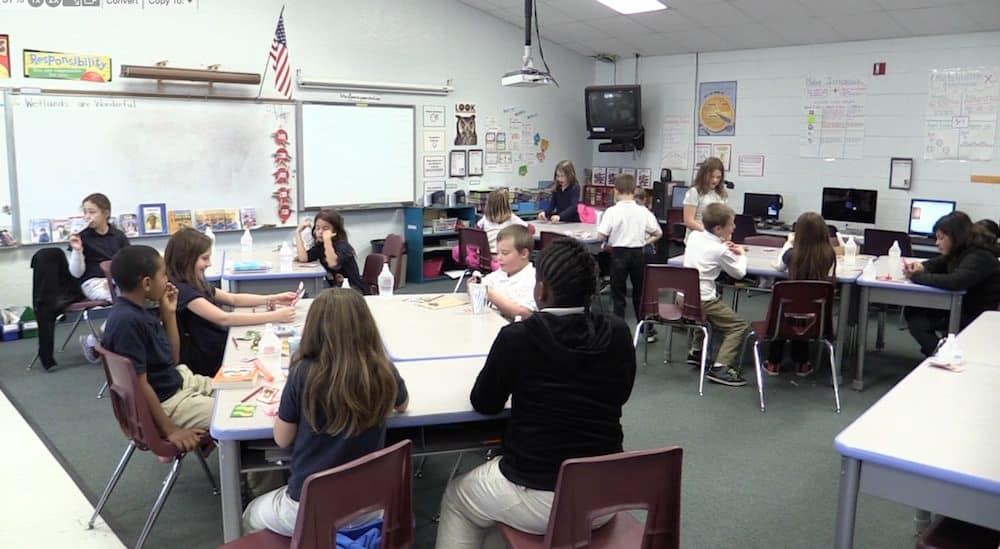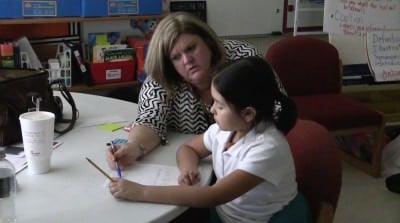

In the wake of the state’s release of school letter grades, many people on both sides of the aisles have expressed concern and confusion — concern about the formula used for the grades (80 percent achievement and 20 percent growth), and confusion about what growth is and how it is calculated. Growth “compares the actual performance of the school’s students to their expected performance based on their prior testing performance.”


Statewide, more than two-thirds of the schools received Cs, Ds or Fs, and only five percent got As. Those schools with more than 50 percent of the students qualifying for free and reduced price lunch tended to receive lower grades.
Which made me wonder what these schools with lower letter grades would look and feel like if you walked the halls. Would they be poor facilities with lackluster teachers and students living in academic despair?
So I went to Jones County to take a look.
Jones County is one of those high-poverty districts. It’s predominantly an agricultural community — a lot of hog farms and open space. Superintendent Michael Bracy says that 82 percent of county students are on free-and-reduced price lunch, and all six schools in the district received either a C or a D.
A closer look at the schools in Jones County let’s us explore the importance of growth.
“If growth were factored in a larger percentage than 20 percent, I think that outcome would have been different,” Bracy said of the grades his schools received.
All Jones County Schools either met or exceeded academic growth. One — Trenton Elementary School, which received a C — is a Title I Rewards School, which means it scored in the top ten percent for all North Carolina Title I schools in either performance or growth.
“I was a little disappointed because I don’t think [the grades are] a true reflection of our school,” said Trenton Elementary Principal David Moody. He said he was hopeful his school was going to receive a B.


Trenton fourth grade teacher Jenny Seaberg strongly disagrees with the grade. She said growth should have been emphasized more.
“If a student comes to fourth grade, and they made a 1 on the third grade EOG (End of Grade Test), the likelihood of them making a 4 on my EOG is hard,” she said. “But now if they go from a 1 to a high 2 or even a low 3, to me that’s more important, because that’s meeting the individual needs of that child.”
Both Trenton Elementary and Comfort Elementary Schools (which received a D) seemed vibrant and alive with engaged teachers and students. I passed a wall of posters at Comfort Elementary. They were part of a contest where students created artworks of wetlands. The project is sophisticated, with QR (quick response) codes that can be scanned to provide a mini-lesson on the content.


The lower grades didn’t seem to be reflective of the schools; instead it seemed reflective of the socioeconomic status of its students.
Children from lower socio-economic backgrounds tend to have less advantages. They may have single parents who are overworked, be encouraged to read less at home, or not have access to tutors or extra-curricular learning activities. The schools have to help them grow.
“We get what comes through our door, be they high achievers or low achievers,” Bracy said.
Dawn Hunter, principal of Comfort Elementary School said that resources also play a role in a schools outcome.
“I think that an A school probably has a higher financial support from parents,” she said.
Her school’s PTA may be able to raise $3,000 to help with the schools’ budget, but a school in a higher income area may be able to raise 10s of thousands of dollars.
It’s also worth noting, however, that while many of the schools receiving lower grades had majority low-income students, that’s not true of every school. In fact, 17 A schools had 50 percent or more free and reduced price lunch students population. This is not a simple issue.


Regardless, there are efforts to change the A-F formula. Democrat Sen. Josh Stein has a bill that would change the formula to 60 percent growth and 40 percent achievement.
State Superintendent June Atkinson said (23:03 in the superintendent’s video) she would be in favor of two separate grades: one for growth and one for achievement. She would want both of them to be weighted equally and then averaged together.
And John Hood, president of the John William Pope Foundation, has said that a 50-50 split makes sense.
Bracy said he wants students in Jones County to perform as well as they possibly can. In fact, he regularly monitors school achievement and already had improvement plans in place for areas where he found weaknesses. But achievement isn’t everything.
“It’s just that one shot deal,” he said. “Most importantly you want those kids to grow.”
Gov. Pat McCrory’s education advisor Eric Guckian said one of his children goes to a school that received a less-than-stellar grade.
“We do think it’s a good school, and the proficiency grade represents that we have some work to do,” he said.
But he said that downplaying school proficiency as a part of these grades isn’t an option.
“What I am arguing is that dismissing these grades as not being relevant to schools and communities is watering down and perhaps white-washing,” he said.
However, Guckian said that North Carolina can learn from states like Florida that perhaps a third component should be considered in addition to the other two: narrowing achievement gaps. Still, he thinks the current formula has value and schools should use it to better their students.
“We are where we are with this now and we ought to learn from it,” he said.

